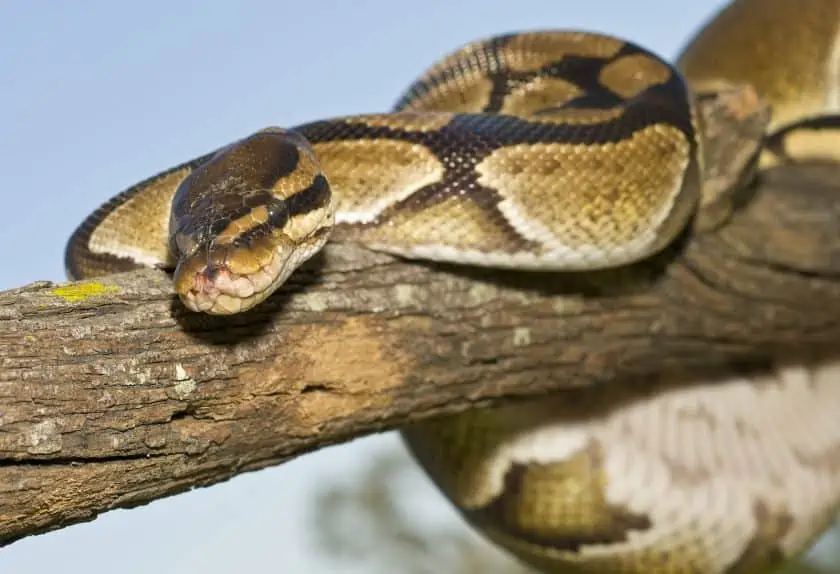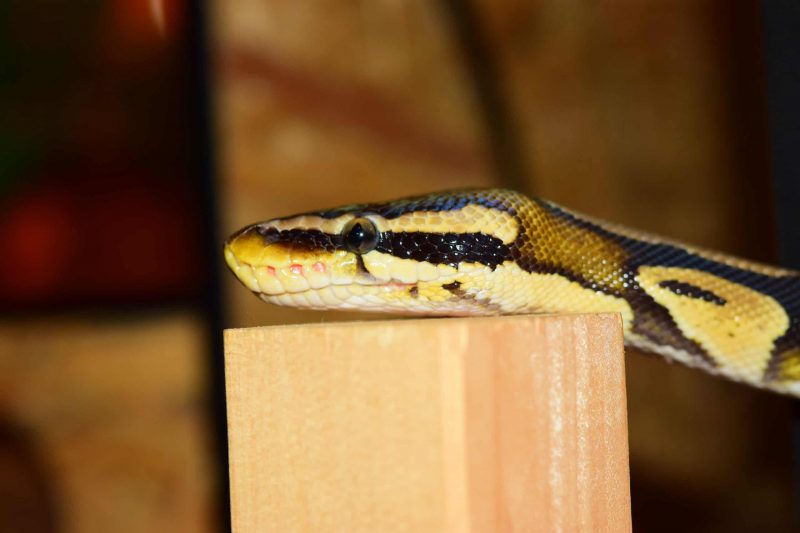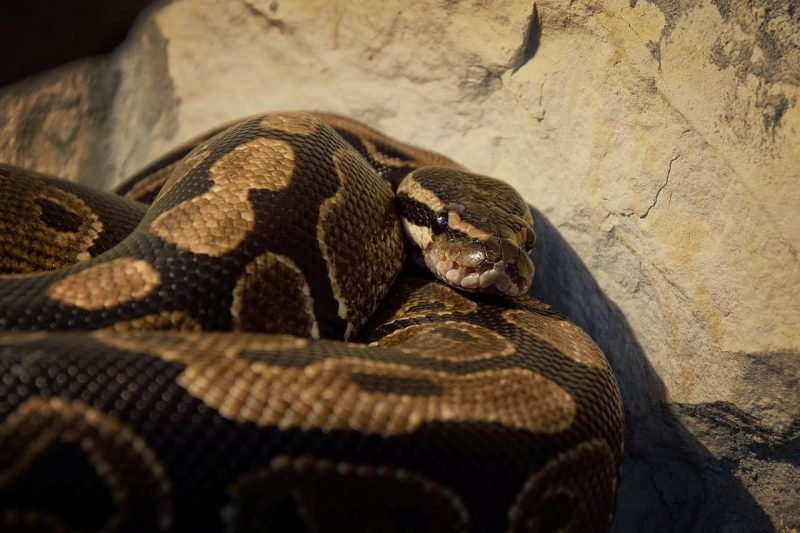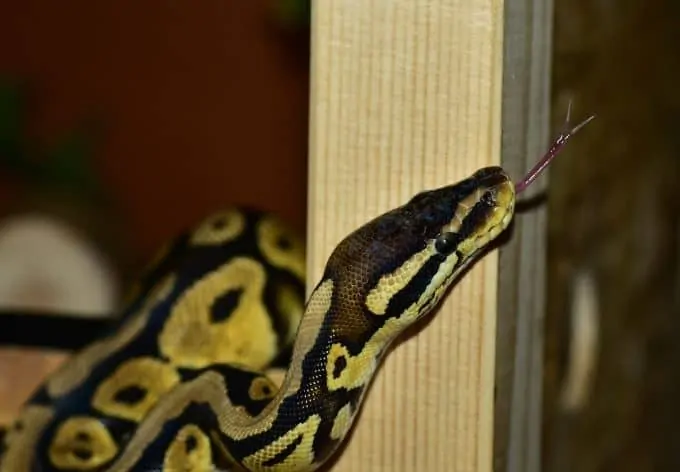It is every pet owner’s nightmare to see their beloved animal suffering and dying in front of them. The feeling of helplessness is devastating and when it comes to our scaly friends, it can be even harder to tell what’s wrong.
So, how can you tell if your ball python is dying? Fortunately, there are a few key signs to look for in order to determine whether or not your ball python is in trouble.
Here are some quick telltale signs:
- Lack of Appetite
- Severe Weight Loss
- Abnormal Posture
- Dehydration
- Inactivity and Lethargy
- Swelling of the Body
- Change in Skin Coloration or Appearance
- Isolative Behavior
- Breathing Difficulties
- Poor Coordination
- Unusual Lumps or Swellings
- Regurgitation
We will go into more detail about each of these signs below and what they might mean for your ball python’s health.
Remember: Time is of the essence when it comes to your sick reptiles.
10 Signs of a Dying Ball Python
Snakes are masters of disguise, and they often do a good job of hiding their illness until it is too late. However, by being aware of the early signs of illness and impending death in your ball python, you can take action to save its life.
However, before we get into that, it’s important to understand that not all ball pythons will exhibit the same symptoms when they are dying. In fact, some ball pythons may not show any obvious signs of illness until they are close to death.
Let’s walk you through each sign so that you know what to look for.
1. Lack of Appetite
I still remember the first time I ever saw a ball python that was near death. It was brought into the hospital I was working at, and it hadn’t eaten in months. It was a sad sight, but we did everything we could to try and save it.
Sadly, the python didn’t make it, but that experience stuck with me. I’ve never seen an animal that sick before, and it really opened my eyes to how important it is to care for our pets properly.
If you have a ball python or any other pet snake, it’s important to make sure they are getting the proper nutrition and care. Don’t let your snake suffer like the one I saw, make sure to give them the best care possible.
If your ball python is already underweight, a loss of appetite can be especially dangerous and potentially fatal. A healthy ball python can survive weeks without eating, they will not start to suffer health problems unless they are already underweight. If your ball python has not eaten for a prolonged period of time and appears to be losing weight, it is important to seek professional help.
A loss of appetite may be due to a number of factors, such as:
- Stress from a new environment
- Improper cage temperature
- Incorrect humidity level
- Lack of hiding places or overstimulation from handling
Skin Shedding
In some cases, a ball python may go off its food because it is about to shed. If this is the case, you should see your snake’s appetite return to normal once the shedding process is complete.
Old Age
Old age can also be a factor in lack of appetite and weight loss, as a snake’s metabolism slows down as it gets older.
However, many things can be done to help get your snake back on track and improve its health. So don’t give up hope yet!
2. Abnormal Posture
Ball pythons who are sick or dying will often stretch out their body for a prolonged period of time, hold their head in elevated positions, or unusually coil their body. This stargazing behavior is often a sign that the snake is having respiratory problems.
Stargazing is a condition where the snake lifts its head and looks up for long periods of time. This is often a sign that the snake is having IBD or Inclusion Body Disease. IBD is a fatal neurological disease that affects snakes and other reptiles.
Symptoms of IBD include:
- Weight loss
- Loss of appetite
- Lethargy
- Stargazing.
In addition to IBD, there are other causes of abnormal posture in ball pythons, including:
- Respiratory infections
- Metabolic bone disease
- Para myxovirus
- Neurological diseases
There is no cure for IBD, and it is often fatal. So if your snake is stargazing, it is important to take it to the vet right away.
> Must Read: The Complete Ball Python Care Sheet
3. Severe Weight Loss
In addition to a lack of appetite, a sudden and drastic loss of weight is another one of the most common and noticeable signs of a dying ball python.
A healthy ball python will typically weigh 4-5 pounds (1.8-2.2 kg). This varies depending on the snake’s sex, age, and species. If your snake is losing weight and its bony spines are becoming more prominent, it is an indication that something is seriously wrong.
Weight loss can be caused by many factors, including:
- Lack of appetite
- Internal parasites
- Metabolic bone disease
- Respiratory infections
4. Dehydration
Dehydration is a serious issue in reptiles, including ball pythons. If your snake is dehydrated, you may notice several symptoms, including cloudy and sunken eyes, weight loss, and a lack of appetite. if you’re not sure whether your ball python is dehydrated, look for these signs:
- Sunken eyes
- Dry and flaky skin
- Loss of appetite
- Lethargy
Dehydration in ball pythons can cause a variety of health problems, including an inability to regulate body temperature, seizures, and even death. If you notice your ball python is dehydrated, it’s important to get him rehydrated as soon as possible.
One way to do this is by providing your ball python with a water dish that is large enough for it to soak in. You can also try misting your ball python’s enclosure with water or offering him a bath.
if you notice any of these signs, it’s important to seek medical attention from a reptile veterinarian as soon as possible.
5. Inactivity/Lethargy
The normal activity of a ball python is to spend the majority of its time coiled up and sleeping. In fact, they can go for weeks without food or water and remain perfectly. However, when a ball python is dying, it will become lethargic and inactive. This is likely because the animal is no longer able to sustain itself and is slowly dying.
However, when a ball python is dying, it will become increasingly lethargic and may even stay in the same spot for hours or days at a time. This is because the snake’s body is no longer able to generate the energy it needs to move around. Additionally, the snake’s vision and hearing may start to fade, causing it to become even more inactive.
The changes in a ball python’s behavior when it is near death are simply a result of its body shutting down. The snake is no longer able to hunt or flee from danger, so it becomes increasingly passive until it finally passes away.
However, if the lethargy is due to disease, treatment may be necessary to save your snake’s life.
6. Bubbles Around Its Nostrils
When a ball python is dying, one of the first things you might notice is that it starts to produce bubbles around its nostrils. This is a sign that the snake is having trouble breathing, and it usually means that the end is near.
There are a few different reasons why this might happen.
- One common reason is that the snake has aspirated (inhaled) vomit or another foreign object into its lungs. This can cause serious respiratory problems and ultimately lead to death.
- Bubbles around its nostrils could be an internal infection or blood clot. In either case, the snake’s condition is likely to deteriorate rapidly and it will soon die.
7. Change in Skin Coloration or Appearance
The skin of a ball python can change color in many ways as it nears the end of its life. It may become darker or lighter, or it may lose its usual patterns and become mottled or blotchy. The body may also become bloated, and the snake’s eyes may become cloudy or sunken in.
These changes occur because the snake is no longer able to maintain its normal bodily functions. The toxins that are building up in its system are causing the skin to change color and the body to swell. The snake’s eyesight is also deteriorating, making it harder for it to find food or escape from predators.
8. Isolation Behavior
One of the most noticeable changes in a ball python’s behavior, when it is dying, is that it will start to isolate itself from the rest of its enclosure. The snake will stop basking in the heat lamp and will instead hide away in the cool, dark corners of its cage.
This may be because they are in pain and don’t want to be around anyone or it could be because they know that they are about to die and are preparing for the end. Whatever the reason, it is a clear sign that your ball python is not doing well.
If you see your snake withdrawing from its normal behavior, it is important to take steps to help him as soon as possible.
> Further Reading: The Ball Python Behavior
9. Breathing Difficulties
Ball pythons breathe in a very slow and shallow manner. You may not even be able to see their chest moving at all.
As your ball python begins to die, you will start to see changes in its breathing pattern. The most obvious sign will be that the snake will start to breathe more rapidly and deeply. This is an attempt by the ball python to get more oxygen into its system to compensate for the failing organs.
The reason for the breathing difficulties can be many things, such as an illness, poisoning, or a traumatic injury.
10. Poor Coordination
A ball python’s coordination is typically erratic when it is dying. This is because the snake’s nervous system is beginning to fail. As the snake’s muscles start to lose function, it becomes difficult for the snake to control its movements.
This can cause the snake to behave in a seemingly confused manner, wobbling or lurching around as it tries to move. In severe cases, your ball python may even become paralyzed and unable to move at all.
How Can You Save a Dying Ball Python?
As a veterinarian, there are a few things that I would recommend in order to help save a dying ball python. First and foremost, it’s important to keep the animal as stress free as possible. This means minimizing movement and noise and keeping the environment at a consistent temperature. If possible, you should also try to provide some humidity in the air – this can be done by placing a wet towel near the snake’s enclosure.
If the snake is having difficulty breathing, you can try gently misting its body with water. If it is constipated, you can try offering it a small amount of water or olive oil. And finally, if the snake has stopped moving altogether, you can try gently manipulating its body in order to stimulate circulation.
In most cases, these steps will be enough to help revive a dying ball python. However, if the snake does not respond to these measures, then it is likely beyond help and you should consult a qualified veterinarian.
Is My Ball Python Dead Or Hibernating?
I would tell you not to worry if your ball python is inactive and doesn’t seem to be moving. In many cases, this can be a sign that the ball python is in a state of hibernation.
Hibernation is a natural process that reptiles undergo when the temperature drops and food becomes scarce. During this time, reptiles will lower their metabolism and heart rate to conserve energy. As a result, they may appear to be dead.
However, it’s important to be able to tell whether the snake is hibernating or dead so that you can take appropriate action.
There are a few things you can check to see whether your ball python is hibernating or dead:
- Check for signs of life such as movement, respiration, and a heartbeat. If you see any of these signs, then your ball python is probably just hibernating.
- Check the temperature of the environment. If it’s too cold, then the snake may be trying to hibernate.
- Look for signs of dehydration such as sunken eyes or wrinkled skin. If the snake is dehydrated, then it may be trying to hibernate.
- Try to stimulate the snake by offering food or moving it to a warmer environment. If the snake responds, then it’s probably just hibernating.
If you’re still not sure whether your ball python is hibernating or dead, then you should consult a veterinarian.
What Does A Dehydrated Ball Python Look Like?
Dehydration can be deadly for reptiles, so it’s not something to take lightly. If you’re concerned that your ball python might be dehydrated, there are a few signs you can look for; such as
- Sunken eyes
- Wrinkled skin
- Loss of elasticity in the skin
The ball python will also be lethargic and may have trouble moving.
If you think your ball python is dehydrated, it’s important to take it to the vet for treatment right away.
There are a few things you can do to help prevent dehydration in your ball python.
- Make sure your ball python has access to fresh water at all times
- Try to keep the environment humid
- You can also give ball python a misting with water once a day
Why Is My Ball Python Lethargic?
If you’re noticing your ball python is lethargic, don’t be afraid. It’s common for ball pythons to experience a period of lethargy during their shedding cycle.
If your ball python is otherwise healthy and you’re sure they’re not in the middle of shedding, there are a few things that could be causing their lethargy.
- It could be something as simple as being too cold or too hot. If your ball python’s enclosure is too cold, it could be causing them to be lethargic. Make sure the temperature is between 75 and 80 °F
- Another possibility is that your ball python isn’t getting enough food. If he is not eating enough, he won’t have the energy they need to be active. Make sure you’re feeding them appropriately for his size and age. If you’re not sure, ask your veterinarian for advice.
As long as your reptile is eating and drinking normally, there’s no cause for concern. However, If your ball python is showing other signs of illness, such as loss of appetite, weight loss, and difficulty moving, it’s important to take it to the vet for a check-up.
There are a few things you can do to help reduce your ball python’s stress levels and make them feel more comfortable.
- Make sure their environment is calm and quiet
- Avoid handling them too much
- Try not to move their cage around a lot
- Give them time to adjust
How Cold Can A Ball Python Get Before It Dies?
As cold-blooded animals, reptiles are very sensitive to changes in temperature. If the temperature gets too low, they can become sluggish and may even go into a state of hibernation. If it gets too high, they can become dehydrated and overheat.
So how cold can a ball python get before it dies? The answer is it depends. If the temperature drops too low, it can cause respiratory problems and even death.
However, if the python is healthy and acclimated to cooler temperatures, it can survive in temperatures as low as 50 °F.
To help your ball python stay warm in colder weather, there are a few things you can do.
- Use a ceramic heat lamp to provide a basking spot for your reptile.
- Make sure their enclosure is well-insulated and draft-free.
- Use a reptile heater pad to help keep the enclosure warm.
- Give your ball python a hide box to retreat to when they need to warm up.
When Should I Take My Ball Python To The Vet?
If you’re concerned that your snake might be sick or injured, it’s important to take it to the vet for treatment right away. The vet can help diagnose and treat any issues your snake may have.
There are a few signs that may indicate your ball python needs to see a veterinarian.
- Not eating or drinking
- Has lost weight
- Lethargic or inactive
- Difficulty moving
- Shedding excessively
- Has any open wounds
If you notice any of these signs, it’s important to take your ball python to the nearest vet right away. Early diagnosis and treatment can often help resolve the issue and prevent further problems.
Remember, the most important thing is to stay calm and act quickly. With the right treatment, your snake can make a full recovery. As a Veterinarian, I want to make sure everyone has the best information possible to keep their snakes healthy and happy. Please share your own experiences and thoughts in the comments below, and be sure to share this article if you liked it.






